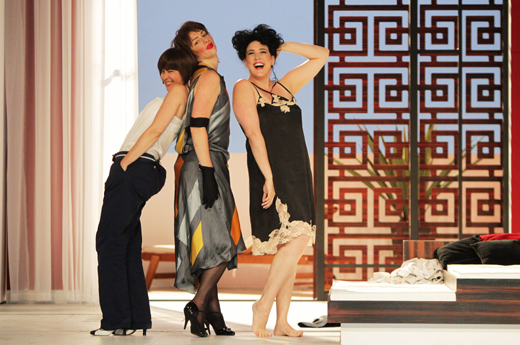 France W.A.Mozart, Le nozze di Figaro: Soloists, Orchestre Bordeaux Aquitaine, Choeur Opera National de Bordeaux, Mikhail Tatarnikov (conductor), Grand Théâtre, Bordeaux, 23.6.2012 (JMI)
France W.A.Mozart, Le nozze di Figaro: Soloists, Orchestre Bordeaux Aquitaine, Choeur Opera National de Bordeaux, Mikhail Tatarnikov (conductor), Grand Théâtre, Bordeaux, 23.6.2012 (JMI)
New Production
Direction: Laurent Laffargue
Sets: Philippe Casaban and Eric Charbeau
Costumes: Hervé Poeydomenge
Lighting: Patrice Trottier
Cast:
Figaro: David Bizic
Susanna: Henriette Bonde-Hansen
Countess: Susanna Phillips
Count Almaviva: Trevor Scheunemann
Cherubino: Jennifer Holloway
Marcellina: Sophie Pondjiclis
Don Bartolo: François Harismendy
Barbarina: Olivera Topalovic
Basilio: Vincent Delhoume
Antonio: David Ortega
Don Curzio: Bruno Moga

Like its Don Giovanni, this Bordeaux Mozart-production is by Laurent Laffargue and his team, but unlike the decade-old Don, this one is new. Generally, the production works well, even though the decision to bring the action to the 20’s creaks occasionally. The stage makes partial use of sets from Don Giovanni (performed thef the day before, S&H review here). The third act takes place in a small theater on the real stage, as if the characters were playing a comedy, with all of them dressed in 18th century costumes. The lighting is more important than in Don Giovanni, ceding to the conventionality that nights are dark. Laurent Laffargue direction is very elaborate, but not everything is easy to understand. Particularly the presence of a gaggle of extras dressed as brides-to-be who err around the stage. The first act probably works best, where Laffargue makes excellent use of large cardboard moving boxes with which Figaro’s and Susanna’s moved their gear into “la più comoda stanza del palazzo”. These boxes serve as the hiding places for Cherubino and the Count. Susanna, the Count and Cherubino are well directed, but perhaps Laffargue could stop insisting on showing people move about on stage, during the other characters’ arias.
  W.G.Mozart, Le nozze di Figaro, R.Jacobs / Concerto Köln / V.Gens, P.Ciofi, A.Kirchschlager, L.Regazzo, S.Keenlyside et al. Harmonia Mundi     |
Mikhail Tatarnikovov conducted, as he did the night before. The result was little more than excessive sound and, above all, a lack of proper balance between the different sections of the orchestra. Right from the overture the winds were too loud, and covered the strings. When inspirational leadership was most needed, none came, and at times the tempi were faster than feasible that night, particularly for the long concertante that ends the second act.
The cast worked out better here than it did for Don Giovanni and responded largely to what can be expected from Bordeaux: young voices, not too well known at the moment, but with a bright future. Figaro was played by young bass-baritone David Bizic, who showed a remarkable voice, attractive and well suited for the demands of the character. He’s much improved from when I saw him last a few years ago.
Danish soprano Henriette Bonde-Hansen wasn’t in any particular way exceptional as Susanna, but she has a well-managed voice, an attractive stage presence, and fine expressive qualities which made her an excellent choice.
Susanna Phillips as the Countess offered the most interesting voice of the cast. As it happens with nine out of ten Countesses, she was much better in Dove Sono than in Porgi, amor. American baritone and former Washington National Opera Young Artist Trevor Scheunemann left a very good impression as Count Almaviva. He is a lyric baritone with an attractive timbre, occasionally a little tight at the top, and he knows his singing business. American mezzo soprano Jennifer Holloway made for a delicious Cherubino on stage, a wonderful characterization of a teen boy with every movement of her body. She doesn’t dazzle vocally, but she was good in her two arias.
José Mª Irurzun